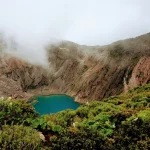
Discovering the Mystical Beauty of Ancient Inca Trails in Peru

The Inca Trail system in Peru is a network of ancient paths that were once used by the Inca civilization. This trail system holds great importance for the Andean people and continues to be a significant cultural and historical site today. The Inca Trail is not only a physical journey through stunning landscapes, but it is also a spiritual pilgrimage that connects people to the ancient traditions and beliefs of the Andean people.
The Enchanting History of the Inca Trail System in Peru
The origins of the Inca Trail can be traced back to the Inca civilization, which flourished in Peru from the 13th to the 16th century. The trail system was constructed by the Incas as a means of transportation and communication between different regions of their vast empire. It served as a vital link between important cities, religious sites, and agricultural areas.
The construction of the Inca Trail was an impressive feat of engineering. The Incas built stone pathways that stretched for thousands of miles, traversing mountains, valleys, and rivers. These pathways were carefully constructed to withstand the test of time and are still visible today. The trail system played a crucial role in Inca society, allowing for trade, military movements, and religious pilgrimages.
Throughout history, many significant events took place along the Inca Trail. It was along these paths that the Inca emperor, Pachacuti, led his armies to conquer neighboring territories and expand the empire. It was also along these paths that Spanish conquistadors, led by Francisco Pizarro, marched towards Cusco and ultimately brought about the downfall of the Inca civilization.
The Spiritual Significance of the Inca Trail for the Andean People
For the Andean people, the Inca Trail is not just a physical journey but also a spiritual pilgrimage. The Andean people have deep-rooted spiritual beliefs and practices that are closely tied to the natural world. They believe that the mountains, rivers, and valleys are inhabited by powerful spirits and deities.
The Inca Trail is considered a sacred route that connects the spiritual realms of the Andean people. It is believed that by walking along this trail, one can connect with the spirits of their ancestors and seek guidance and blessings. Many Andean people still undertake pilgrimages along the Inca Trail today, seeking spiritual enlightenment and healing.
The Inca Trail also plays a significant role in Andean spirituality today. It is a place where traditional ceremonies and rituals are still performed, honoring the ancient traditions of the Andean people. The trail is seen as a living testament to the spiritual beliefs and practices of the Andean people, and it continues to inspire awe and reverence.
Exploring the Ancient Inca Trail: A Journey Through Time
The Inca Trail is divided into different sections, each offering its own unique experience. The most famous section of the trail is the one that leads to Machu Picchu, one of the New Seven Wonders of the World. This section is known for its stunning views of mountains, cloud forests, and ancient ruins.
Hiking the Inca Trail is not an easy feat. The trail can be challenging, with steep ascents and descents, high altitudes, and unpredictable weather conditions. However, the rewards are well worth it. Along the way, hikers will encounter breathtaking landscapes, hidden ruins, and a sense of awe and wonder.
The Natural Wonders Along the Inca Trail: Mountains, Rivers, and Valleys
One of the most remarkable aspects of the Inca Trail is its diverse landscapes. The trail takes hikers through towering mountains, lush valleys, and crystal-clear rivers. Each section of the trail offers its own unique beauty and natural wonders.
The Andean region is known for its rich biodiversity, and the Inca Trail is no exception. Hikers will encounter a wide variety of flora and fauna along the trail, including orchids, hummingbirds, and Andean condors. The trail also passes through several ecological zones, from high-altitude grasslands to dense cloud forests.
Preserving the natural environment of the Inca Trail is of utmost importance. Efforts are being made to protect the fragile ecosystems along the trail and promote sustainable tourism practices. Visitors are encouraged to respect the natural environment and leave no trace behind.
The Inca Trail’s Hidden Gems: Uncovering the Lesser-Known Sites
While Machu Picchu is undoubtedly the highlight of the Inca Trail, there are many other lesser-known ruins and sites that are worth exploring. These hidden gems offer a glimpse into the daily life of the Inca civilization and provide a deeper understanding of their culture and history.
Some of these lesser-known sites include Wiñay Wayna, Intipata, and Sayacmarca. These ruins are often less crowded than Machu Picchu and offer a more intimate experience. Exploring these hidden gems allows visitors to connect with the ancient past and appreciate the ingenuity and craftsmanship of the Inca civilization.
The Inca Trail’s Sacred Sites: Discovering Mystical Ruins and Temples
The Inca Trail is dotted with mystical ruins and temples that hold great spiritual significance for the Andean people. These sites were once important religious centers where ceremonies and rituals were performed to honor the gods and seek their blessings.
Some of the most significant sacred sites along the Inca Trail include Inti Punku (the Sun Gate), Intipata (the Terrace of the Sun), and Phuyupatamarca (the Town Above the Clouds). These sites offer breathtaking views of the surrounding landscapes and provide a glimpse into the spiritual beliefs and practices of the Inca civilization.
It is important to respect and preserve these sacred sites. Visitors are encouraged to follow the guidelines set forth by the local authorities and refrain from touching or removing any artifacts. By treating these sites with reverence, we can ensure that future generations can continue to appreciate their beauty and significance.
The Inca Trail Today: Balancing Preservation and Tourism
Preserving the Inca Trail while accommodating tourism is a delicate balance. The trail attracts thousands of visitors each year, and this influx of tourists can have a significant impact on the environment and the local communities.
Efforts are being made to protect the Inca Trail and its surrounding environment. Strict regulations are in place to limit the number of visitors allowed on the trail each day, and permits must be obtained in advance. Additionally, tour operators are required to follow responsible tourism practices, such as carrying out waste management and promoting sustainable practices.
Visitors to the Inca Trail can also play their part in preserving this ancient site. By respecting the rules and regulations, minimizing their impact on the environment, and supporting local communities, visitors can ensure that the Inca Trail remains a pristine and enchanting destination for future generations.
Preparing for the Inca Trail: Tips for a Safe and Memorable Journey
Hiking the Inca Trail requires careful preparation both physically and mentally. The trail can be physically demanding, with long hours of hiking at high altitudes. It is important to be in good physical condition and acclimatize to the altitude before embarking on the journey.
Mental preparation is also crucial. The Inca Trail can be challenging, both physically and emotionally. It is important to be mentally prepared for the physical exertion, as well as any unexpected challenges that may arise along the way.
Choosing a reputable tour operator is essential for a safe and memorable journey. Look for operators that prioritize safety, sustainability, and responsible tourism practices. It is also important to pack appropriately, with essential items such as sturdy hiking boots, warm clothing, and a good quality backpack.
The Inca Trail’s Culinary Delights: Tasting Traditional Andean Cuisine
The Andean region is known for its unique cuisine, and the Inca Trail offers the opportunity to taste traditional Andean dishes. The cuisine of the Andean people is diverse and reflects the rich agricultural heritage of the region.
Some traditional dishes that can be found along the Inca Trail include ceviche, quinoa soup, and lomo saltado. These dishes are made with locally sourced ingredients and reflect the flavors and traditions of the Andean people.
Food holds great importance in Andean culture and society. It is seen as a way to connect with nature and honor the spirits of the land. By tasting traditional Andean cuisine along the Inca Trail, visitors can gain a deeper appreciation for the culture and traditions of the Andean people.
The Inca Trail’s Legacy: How the Inca Civilization Continues to Inspire and Enchant
The Inca civilization has left a lasting impact on Peru and the world. Their advanced engineering techniques, intricate stonework, and spiritual beliefs continue to inspire awe and admiration.
The Inca Trail plays a crucial role in preserving and sharing this legacy. It allows visitors to step back in time and experience the grandeur of the Inca civilization firsthand. The trail serves as a reminder of the ingenuity, craftsmanship, and spirituality of the Andean people.
The enduring enchantment of the Inca Trail is not only significant for its historical value but also for its ability to inspire future generations. By exploring this ancient trail system, we can gain a deeper understanding of our shared human history and appreciate the beauty and wonder of the natural world.
The Inca Trail in Peru is an enchanting trail system that holds great importance for the Andean people. It is a physical and spiritual journey that allows visitors to connect with the ancient traditions and beliefs of the Andean people.
The Inca Trail offers a glimpse into the rich history, diverse landscapes, and spiritual significance of the Andean region. It is a place of awe and wonder, where ancient ruins, mystical temples, and breathtaking landscapes come together to create an unforgettable experience.
By exploring and appreciating the Inca Trail, we can gain a deeper appreciation for the ingenuity, craftsmanship, and spirituality of the Inca civilization. It is a journey through time that continues to inspire and enchant visitors from around the world.
If you’re fascinated by ancient civilizations and love exploring historical trails, then you must check out this article on Ancient Inca Trails in Peru. These trails offer a glimpse into the rich history and culture of the Inca Empire. But if you’re looking for other tropical paradises to explore, you might want to read about Maui, a tropical paradise awaiting your footprints. This article takes you on a journey through the stunning landscapes and vibrant culture of this Hawaiian island. So whether you’re interested in Peru’s ancient trails or Maui’s tropical beauty, Destination Mate has got you covered.
Recent Posts


Discovering the Pura Vida Lifestyle: A Journey Through Costa Rica
